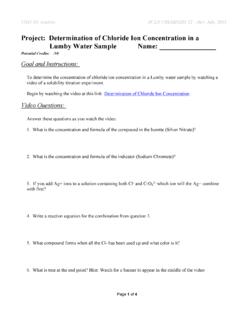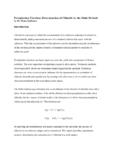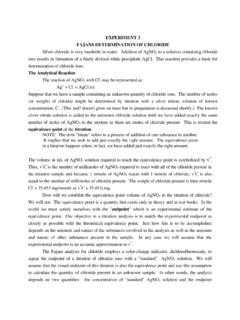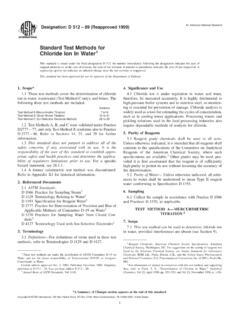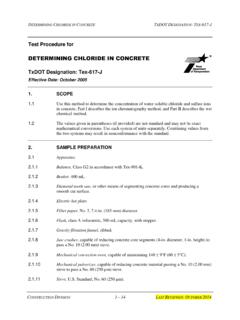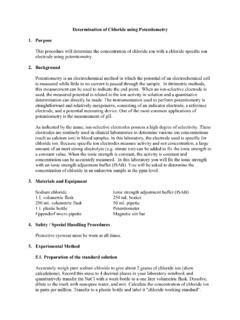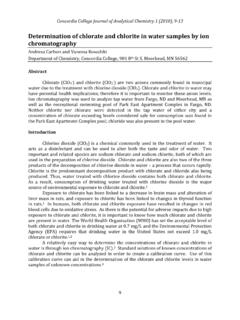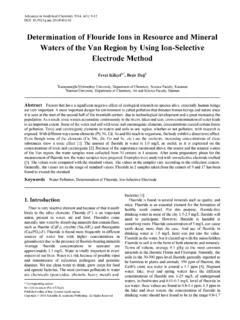Transcription of Determination of Chloride Ion content using Ion Selective ...
1 Determination of Chloride Ion content using Ion Selective Electrodes before you come to class: 1. Write the Nernst Equation in your notebook. Reagents: 10,000. ppm Chloride ion solution 1 M (10%) potassium nitrate solution to use as electrode filling solution 1 M sodium nitrate solution to use as Ionic Strength Adjustment (ISA) buffer Waste Disposal: All solutions in today s lab can be disposed of down the sink with running water. Safety Considerations: There are no significant safety hazards associated with this laboratory procedure. Experimental Procedure Preparing standard solutions: using the 10,000. ppm solution provided, make the following dilutions. You can use the dilution equation (M1V1 = M2V2) to determine what volumes to use.
2 Make each solution in a 250-mL volumetric flask, using pipets. For instance, the first dilution you will make is 1,000. ppm. Pipet 25-mL of the 10,000. ppm solution into a 250-mL volumetric flask, then dilute to the mark with distilled water. Use this solution to make the next dilution. This is called doing serial dilutions, when you used the previously made dilution to make the next one. using a graduated cylinder, transfer 100-mL of each standard into separate 250-mL beakers (labeled with tape.) Preparing unknown solution: Weigh approximately 5 g of your unknown, to the nearest mg, into a 100-mL volumetric flask. Dilute halfway and mix until unknown is dissolved, then dilute to the mark. Transfer this solution to a 250-mL beaker. Preparing the pH/ISE meter: You will need a waste beaker to use for washing the Chloride ISE probe, your water bottle and some Kimwipes.
3 Plug the Chloride ISE into the meter using the BNC connector. Loosen the screw cap on the electrode storage bottle, then pull the probe out of the bottle. Because the tip of the probe must be hydrated at all times, this bottle contains a solution of 10 ppm Cl- for storage. Please try not to spill the solution in this bottle but if you do please let your instructor know so they can add more. When you finish with the experiment today, you will slide the probe back into the storage bottle (all the way down, so the tip is immersed in the buffer) and tighten the cap so it is ready for storage. Put the probe into a beaker with DI water while it is not being used; never leave the probe out of liquid because it will dry out. Also, don t put it on the benchtop lying on its side the probe contains 10% KNO3 which can leak out of the hole near the top of the probe, even though the hole is covered with a ring of black plastic.
4 using the pH/ISE meter: Be sure to (1) rinse the tip of the ISE probe after each measurement with DI water (collect the rinse in your waste beaker throughout the experiment; when you are finished you can pour it down the sink) and (2) gently pat it dry with a Kimwipe (not a paper towel) before putting the probe into another solution. The tip of the probe is a very thin, very sensitive membrane that can easily scratch or break so do this very gently while ensuring that the probe is dry after every rinse. Making measurements: Make a table like this in your lab notebook, with a row for each standard solution: [Cl-] Potential (mV) Trial 1 Trial 2 Trial 3 Have all of your 250-mL beakers ready to measure before you start. If your meter is not reading mV, press the mode button (this will change the readout from pH to mV.)
5 Starting with the most dilute standard: put the 250-mL beaker on your magnetic stirrer, stirring gently. using a pipet, add 2 mL of the ISA (ionic strength adjuster, a solution of 5M NaNO3) to the 100 mL of Chloride solution in the beaker and continue stirring. Put the Chloride probe into your solution, making sure that it does not touch the bottom of the beaker or come in contact with the magnetic stir bar. Let the reading stabilize for 1 minute and then record the potential in mV. Be consistent with this timing. Some of these numbers may be negative. Record the mV for each. Rinse and dry the probe between solutions, carefully using DI water and kimwipes. Set this solution aside and start with the next dilute standard solution. After you have measured each standard, do the same for your unknown solution and measure its potential in mV.
6 Repeat this two more times (just measuring, don t add more ISA) using magnetic stirring. You should have three readings (in mV) for each solution. Data Analysis: Enter your data into Excel. Calculate the average and the standard deviation of the mV for each solution. Also calculate the 95% confidence interval for each solution. Plot x = -log[Cl-] and y = mV, following the instructions starting on page 95 of your textbook. Make sure to write the line equation and R2 onto your calibration curve. using the instructions starting on page 97 of your textbook, make error bars for each of your standard solutions to include on your calibration curve. (You don t need to make error bars for your unknown). Compare your line equation to the Nernst Equation.
7 using correct significant figures, calculate the % error in your slope: % error = |theoretical slope measured slope| x 100% theoretical slope using the line equation and the average mV you measured for your unknown solution, calculate ppm Cl- in the solution that contained the of unknown. using this number (in ppm, aka mg/L) calculate the % Chloride in your unknown.
